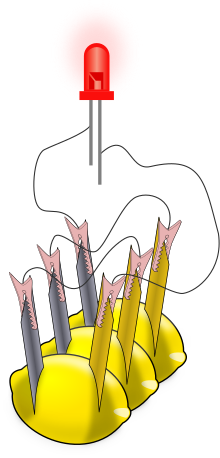Sources of Electricity - PatternAgents/Electronics_One_Workshop GitHub Wiki
Potential Difference
[Potential Difference](https://en.wikipedia.org/wiki/Voltage">Potential Difference) (or Voltage) can be caused by an electrostatic field, by an electric current flowing through a magnetic field, by time-varying a magnetic field, or by some combination of these three. Don't worry, we'll explain each of these in more detail as we go along.
- It is often easier for people to visualize the physics of electrons by comparing them to moving water in a hose/pipe as an analogy :

-
So, the first electronics terms we will cover are the basic parameters of voltage, current, and resistance. By analogy to water they would be :
-
Voltage - analogous to the water pressure
-
Current - analogous to the volume of water
-
Resistance - analogous to the effective diameter of the pipe
-
See, you already have an intrinsic understanding of these physical concepts:
- a bigger pipe can carry more water, just as a bigger wire can carry more electric current
- a clogged pipe has more resistance to the flow of water, just as an imperfect wire has more resistance to the flow of electric current
- a broken pipe delivers no water, just as a broken wire (an "open" circuit) delivers no electric current
The electrical resistance of an electrical conductor is a measure of the difficulty to pass an electric current through that conductor.

Just as a larger diameter pipe can carry more water than a smaller one, a larger diameter wire can carry more electrical current than a smaller one.

Now you just need to learn the terms and symbols to “speak” electronics properly.
Chemical Action
If you have ever used a lemon, or grapefruit to generate electricity as a battery, then you have made a chemical reaction generate electricity. Two dissimilar metals (copper and zinc - find them on the periodic table...) interact with the acid in the lemon, the copper looses electrons and becomes positively charged, while the zinc accepts electrons and becomes negatively charged. Enough electrons (i.e. current) flows to provide a small amount of electricity. This is the basis of how all batteries work.

Batteries
There are many different chemical reactions possible that will generate electricity, as this list of battery types shows. The most common is the Lead Acid Battery found in almost all cars and trucks, accounting for almost half of all batteries worldwide. Newer battery types such as Lithium-Ion have a greater power density, and are the fastest growing battery type.
Below is a basic schematic symbol for a battery, you'll see the long side is the positive(+) side. We typically use the same schematic symbol for all battery types, and specifiy the type as a parameter of the symbol.

I've worked with a great variety of batteries, mostly for my electric vehicles, and we have DIY Instructions for building your own High Performance Battery System , suitable for a large robot or an electric bicycle, or other electric vehicle.
Fuel Cells
A fuel cell is a device that converts the chemical energy from a fuel into electricity through a chemical reaction of positively charged hydrogen ions with oxygen or some other oxidizing agent. Fuel cells are different from batteries in that they require a continuous source of fuel and oxygen or air to sustain the chemical reaction. Fuel cells can produce electricity continuously only for as long as these fuel inputs are supplied.
Early on, fuel cells were only used by NASA, and other high-end, space missions, however now they are becoming commercially available, and system that "cracks" Propane, or Natural Gas into Hydrogen and Oxygen that fuels the cell. It converts Propane directly to Electricity and Hot Water.

The schematic symbol for a fuel cell is shown below:

Thermal Action
Thermal action can also be used to generate electricity, typically through the use of a steam turbine. The BioLite series is an excellent example of what can be done on a small scale for thermal electricity generation.

The schematic symbol for a power generator (general) is as follows:

Mechanical Action
Anything that has physical motion can be harnessed to provide electricity in number of ways, using magnets and electrical wires, or by creating pressure on certain materials, such as crystals.
Piezoelectric
The piezoelectric effect converts mechanical strain into electric current or voltage. This strain can come from many different sources. Human motion, low-frequency seismic vibrations, and acoustic noise are typical examples.

Most piezoelectric electricity sources produce power on the order of milli-Watts (one-thousandth of a Watt), too small for powering any large system applications; but enough for some small hand-held devices, such as a self-winding wrist-watches or exercise monitor, or charging a battery over time.
The schematic symbol for the Piezoelectric source is the same as that of a Crystal, as they are similarly constructed.

Solar Power
Solar power is the conversion of sunlight into electricity, either directly using photovoltaics, or indirectly using concentrated solar power (CSP). Concentrated solar power systems use lenses or mirrors and tracking systems to focus a large area of sunlight into a small beam. Photovoltaics convert light into an electric current using the photovoltaic effect.

The schematic symbol for a photo-voltaic solar cell is show below:
